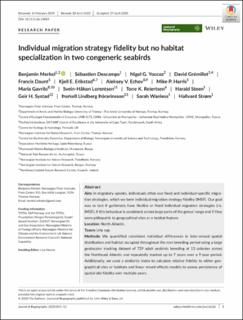| dc.contributor.author | Merkel, Benjamin | |
| dc.contributor.author | Descamps, Sebastien | |
| dc.contributor.author | Yoccoz, Nigel | |
| dc.contributor.author | Grémillet, David | |
| dc.contributor.author | Daunt, Francis | |
| dc.contributor.author | Erikstad, Kjell E | |
| dc.contributor.author | Ezhov, Aleksey V. | |
| dc.contributor.author | Harris, Mike P. | |
| dc.contributor.author | Gavrilo, Maria | |
| dc.contributor.author | Lorentsen, Svein Håkon | |
| dc.contributor.author | Reiertsen, Tone Kristin | |
| dc.contributor.author | Steen, Harald | |
| dc.contributor.author | Systad, Geir Helge Rødli | |
| dc.contributor.author | Þórarinsson, Þorkell Lindberg | |
| dc.contributor.author | Wanless, Sarah | |
| dc.contributor.author | Strøm, Hallvard | |
| dc.coverage.spatial | Northeast Atlantic | en_US |
| dc.date.accessioned | 2020-11-05T13:49:47Z | |
| dc.date.available | 2020-11-05T13:49:47Z | |
| dc.date.created | 2020-11-02T12:08:32Z | |
| dc.date.issued | 2020 | |
| dc.identifier.issn | 0305-0270 | |
| dc.identifier.uri | https://hdl.handle.net/11250/2686610 | |
| dc.description.abstract | Abstract
Aim: In migratory species, individuals often use fixed and individual-specific migration
strategies, which we term individual migration strategy fidelity (IMSF). Our goal
was to test if guillemots have flexible or fixed individual migration strategies (i.e.
IMSF), if this behaviour is consistent across large parts of the genus’ range and if they
were philopatric to geographical sites or a habitat feature.
Location: North Atlantic.
Taxon: Uria spp.
Methods: We quantified consistent individual differences in inter-annual spatial
distribution and habitat occupied throughout the non-breeding period using a large
geolocator tracking dataset of 729 adult seabirds breeding at 13 colonies across
the Northeast Atlantic and repeatedly tracked up to 7 years over a 9-year period.
Additionally, we used a similarity index to calculate relative fidelity to either geographical
sites or habitats and linear mixed-effects models to assess persistence of
spatial site fidelity over multiple years.
Results: Both guillemot species exhibited IMSF across a large part of the genus’ range
which persisted over multiple years. Individuals of both species and almost all colonies
showed fidelity to geographical sites and not to specific habitats.
Main conclusions: Guillemots show IMSF that is best explained by site familiarity (fidelity
to specific sites) rather than habitat specialization (fidelity to specific habitats).
In the context of rapidly changing environments, favourable habitats may permanently
shift locations and hence species displaying IMSF driven by site familiarity—such as
the genus Uria—may not be able to adjust their migration strategies sufficiently fast
to sustain individual fitness and ensure population persistence. | en_US |
| dc.language.iso | eng | en_US |
| dc.rights | Navngivelse 4.0 Internasjonal | * |
| dc.rights.uri | http://creativecommons.org/licenses/by/4.0/deed.no | * |
| dc.subject | guillemots | en_US |
| dc.subject | light-level geolocation | en_US |
| dc.subject | murres | en_US |
| dc.subject | Uria aalge | en_US |
| dc.subject | Uria lomvia | en_US |
| dc.title | Individual migration strategy fidelity but no habitat specialization in two congeneric seabirds | en_US |
| dc.type | Peer reviewed | en_US |
| dc.type | Journal article | en_US |
| dc.description.version | publishedVersion | en_US |
| dc.rights.holder | © 2020 The Authors. | en_US |
| dc.subject.nsi | VDP::Zoologiske og botaniske fag: 480 | en_US |
| dc.subject.nsi | VDP::Zoology and botany: 480 | en_US |
| dc.source.journal | Journal of Biogeography | en_US |
| dc.identifier.doi | 10.1111/jbi.13883 | |
| dc.identifier.cristin | 1844066 | |
| dc.relation.project | Norges forskningsråd: 216547 | en_US |
| dc.relation.project | Andre: TOTAL E&P Norway and the TOTAL Foundation | en_US |
| dc.relation.project | Andre: Norwegian Oil and Gas Association | en_US |
| dc.relation.project | Andre: Norwegian Ministry of Foreign Affairs | en_US |
| dc.relation.project | Andre: Norwegian Ministry for Climate and the Environment | en_US |
| cristin.ispublished | true | |
| cristin.fulltext | original | |
| cristin.qualitycode | 2 | |

